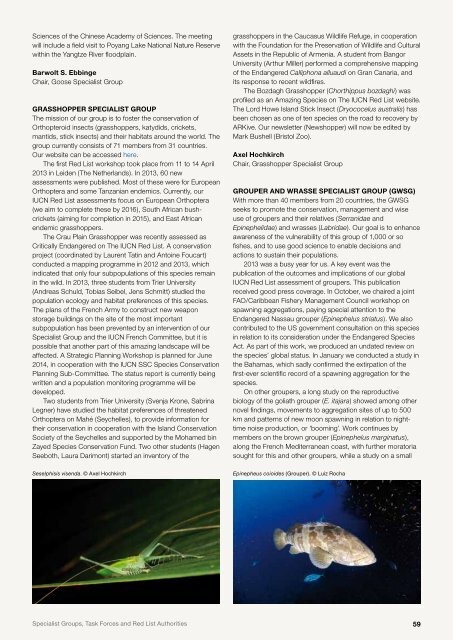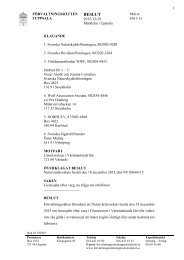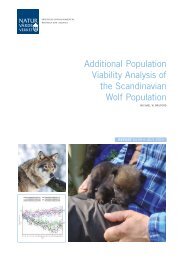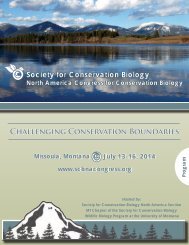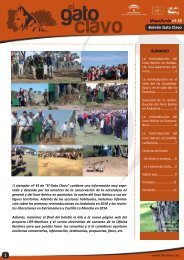1oC3Dbk
1oC3Dbk
1oC3Dbk
Create successful ePaper yourself
Turn your PDF publications into a flip-book with our unique Google optimized e-Paper software.
Sciences of the Chinese Academy of Sciences. The meeting<br />
will include a field visit to Poyang Lake National Nature Reserve<br />
within the Yangtze River floodplain.<br />
Barwolt S. Ebbinge<br />
Chair, Goose Specialist Group<br />
Grasshopper Specialist Group<br />
The mission of our group is to foster the conservation of<br />
Orthopteroid insects (grasshoppers, katydids, crickets,<br />
mantids, stick insects) and their habitats around the world. The<br />
group currently consists of 71 members from 31 countries.<br />
Our website can be accessed here.<br />
The first Red List workshop took place from 11 to 14 April<br />
2013 in Leiden (The Netherlands). In 2013, 60 new<br />
assessments were published. Most of these were for European<br />
Orthoptera and some Tanzanian endemics. Currently, our<br />
IUCN Red List assessments focus on European Orthoptera<br />
(we aim to complete these by 2016), South African bushcrickets<br />
(aiming for completion in 2015), and East African<br />
endemic grasshoppers.<br />
The Crau Plain Grasshopper was recently assessed as<br />
Critically Endangered on The IUCN Red List. A conservation<br />
project (coordinated by Laurent Tatin and Antoine Foucart)<br />
conducted a mapping programme in 2012 and 2013, which<br />
indicated that only four subpopulations of this species remain<br />
in the wild. In 2013, three students from Trier University<br />
(Andreas Schuld, Tobias Seibel, Jens Schmitt) studied the<br />
population ecology and habitat preferences of this species.<br />
The plans of the French Army to construct new weapon<br />
storage buildings on the site of the most important<br />
subpopulation has been prevented by an intervention of our<br />
Specialist Group and the IUCN French Committee, but it is<br />
possible that another part of this amazing landscape will be<br />
affected. A Strategic Planning Workshop is planned for June<br />
2014, in cooperation with the IUCN SSC Species Conservation<br />
Planning Sub-Committee. The status report is currently being<br />
written and a population monitoring programme will be<br />
developed.<br />
Two students from Trier University (Svenja Krone, Sabrina<br />
Legner) have studied the habitat preferences of threatened<br />
Orthoptera on Mahé (Seychelles), to provide information for<br />
their conservation in cooperation with the Island Conservation<br />
Society of the Seychelles and supported by the Mohamed bin<br />
Zayed Species Conservation Fund. Two other students (Hagen<br />
Seeboth, Laura Darimont) started an inventory of the<br />
grasshoppers in the Caucasus Wildlife Refuge, in cooperation<br />
with the Foundation for the Preservation of Wildlife and Cultural<br />
Assets in the Republic of Armenia. A student from Bangor<br />
University (Arthur Miller) performed a comprehensive mapping<br />
of the Endangered Calliphona alluaudi on Gran Canaria, and<br />
its response to recent wildfires.<br />
The Bozdagh Grasshopper (Chorthippus bozdaghi) was<br />
profiled as an Amazing Species on The IUCN Red List website.<br />
The Lord Howe Island Stick Insect (Dryococelus australis) has<br />
been chosen as one of ten species on the road to recovery by<br />
ARKive. Our newsletter (Newshopper) will now be edited by<br />
Mark Bushell (Bristol Zoo).<br />
Axel Hochkirch<br />
Chair, Grasshopper Specialist Group<br />
Grouper and Wrasse Specialist Group (GWSG)<br />
With more than 40 members from 20 countries, the GWSG<br />
seeks to promote the conservation, management and wise<br />
use of groupers and their relatives (Serranidae and<br />
Epinephelidae) and wrasses (Labridae). Our goal is to enhance<br />
awareness of the vulnerability of this group of 1,000 or so<br />
fishes, and to use good science to enable decisions and<br />
actions to sustain their populations.<br />
2013 was a busy year for us. A key event was the<br />
publication of the outcomes and implications of our global<br />
IUCN Red List assessment of groupers. This publication<br />
received good press coverage. In October, we chaired a joint<br />
FAO/Caribbean Fishery Management Council workshop on<br />
spawning aggregations, paying special attention to the<br />
Endangered Nassau grouper (Epinephelus striatus). We also<br />
contributed to the US government consultation on this species<br />
in relation to its consideration under the Endangered Species<br />
Act. As part of this work, we produced an undated review on<br />
the species’ global status. In January we conducted a study in<br />
the Bahamas, which sadly confirmed the extirpation of the<br />
first-ever scientific record of a spawning aggregation for the<br />
species.<br />
On other groupers, a long study on the reproductive<br />
biology of the goliath grouper (E. itajara) showed among other<br />
novel findings, movements to aggregation sites of up to 500<br />
km and patterns of new moon spawning in relation to nighttime<br />
noise production, or ‘booming’. Work continues by<br />
members on the brown grouper (Epinephelus marginatus),<br />
along the French Mediterranean coast, with further moratoria<br />
sought for this and other groupers, while a study on a small<br />
Seselphisis visenda. © Axel Hochkirch<br />
Epinepheus coioides (Grouper). © Luiz Rocha<br />
Specialist Groups, Task Forces and Red List Authorities<br />
59


